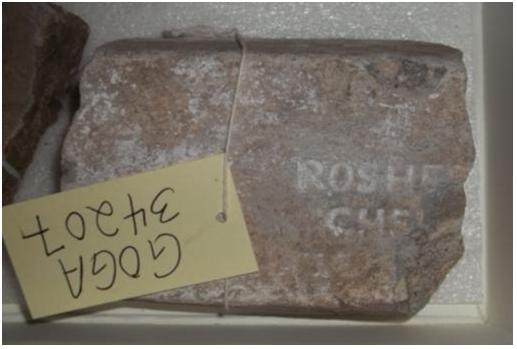The artifact is hollow on the inside and smoothed on the exterior, and appears to be a statue pedestal base. Although not all of the mark is visible, based on the faint outline of the letters we thought that "Rosher" seemed like a good guess for a manufacturer name. Using the ever-trusty-in-historical-archaeology GoogleBooks, we ran a search for "Rosher", "garden", and "statue" in literature of the late 19th century to see what we could find. A number of garden and horticulture periodicals popped up, and we were almost immediately able to identify a possible maker for our artifact: F. Rosher and Co.
In the late 19th century, F. Rosher and Co. was a brick and tile manufacturing company based out of London. In addition to producing utilitarian brick and tile items, the company manufactured a number of decorative items for the home and garden. Here is an 1874 advertisement for F. Rosher and Co.:
http://www.gracesguide.co.uk/F._Rosher_and_Co
Although we were unable to find any information positively identifying our maker's mark "ROSHE…///CHE…" to this company, the time period, type of ornamental artifact made, and their prominence at trade shows gave credence to the idea that F. Rosher and Co. was indeed our manufacturer."Messrs. F. Rosher and Co., of Upper Ground-street, are large exhibitors of vases, fountains, and statues, rustic seats and garden-tiles…"-The Domestic Exhibition at the Agricultural Hall, Islington, 1882. [1]
"Messrs. F. Robert & Co., King's Road, Chelsea, also have an extensive assortment of tasteful edging tiles, for which the bronze medal was awarded, together with a silver medal for decorations for conservatories, ornamental flooring and flower stands."
-Royal Horticultural Society Summer Show, South Kensington, May 1883.[2]
Eventually, we found this photograph of a page from a c. 1920 catalog of F. Rosher and Co.'s ornamental statuary (the catalog is currently being auctioned off by an antique books dealer). What it suggests may be a game-changing insight into current scholarship on the Sutro statues:
Recognize any familiar faces? (We've added the red circles for a hint.)
Each of the eleven red-circled figures from the catalog formally matches a statue at Sutro Heights, as evidenced through historic photographs.
Although we cannot be certain that F. Rosher and Co. manufactured all of the statues at Sutro Heights (in fact it would be extremely unlikely…think of how many different companies manufacture terracotta Venus de Milo garden statues nowadays, for example), finding this many possible matches in just one page of this catalog suggests that lore surrounding the Sutro statues needs to be revised…
Historically, scholars and local historians on Sutro Heights have thought that Adolph Sutro, during his extensive travels in Europe, commissioned copies of grand European statues to be made and sent to him at home in San Francisco for his garden. While this may be true – that favorite statues were selected and custom-made of the best materials – this catalog suggests an alternate story. It raises the possibility that, for at least some of the statues, Adolph Sutro may have simply thumbed through a mail order catalog. We cannot know for certain. Perhaps this company didn't even have a catalog until the 1920s. Perhaps Sutro saw F. Rosher and Co.'s statues at a European trade show and ordered them. Perhaps some of the statues were commissioned, and some were mail ordered.
What we do know is that this research and the German maker's mark of our last discovery show a distinct flow of aesthetic ideas and materials from Europe to San Francisco at this time. Better transportation and information technology during the Victorian era opened up new avenues of international trade and communication. Cities all across the world held expositions and trades fairs to show off new technologies and inventions. San Francisco citizens could obtain luxury items – even as frivolous as garden statuary - from multiple award winning European manufacturers. This is amazing when you remember that the heyday of Land's End was just over 30 years after the Gold Rush – in 1840s, San Francisco had muddy streets and shanties that housed a population of less than 1,000 which boomed to 25,000 by the 1849 Gold Rush, and by the 1880s the city's population of over 233,000 could visit amusement parks, museums, fairs and exhibitions, and classical statuary gardens.[3] By using his staggering wealth from the mining industry to develop the Lands End pleasure grounds, Prussian born Adolph Sutro borrowed heavily from – and made a uniquely American homage to – European culture. Perhaps adolescent Victorian San Francisco was out to prove itself as a cultural contender.
[1] Source: http://books.google.com/books?id=hYEcAQAAMAAJ&pg=PA258&dq=%22f.+rosher%22&hl=en&ei=86okTvnyEJDGsAPr0PnqCA&sa=X&oi=book_result&ct=result&resnum=10&ved=0CE8Q6AEwCTgK#v=onepage&q=%22f.%20rosher%22&f=false )
[2] Source: http://books.google.com/books?id=NVYCAAAAYAAJ&pg=PA434&dq=%22f.+rosher%22&hl=en&ei=HK0kTtnvE4W6sQOLqYSECQ&sa=X&oi=book_result&ct=result&resnum=2&ved=0CCwQ6AEwATgU#v=onepage&q=%22f.%20rosher%22&f=false
[3] http://www.sfgenealogy.com/sf/history/hgpop.htm




